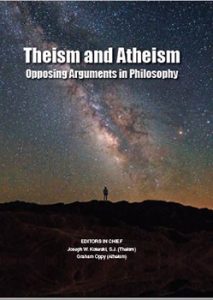| By Laurie Malashanko |
There used to be a show on the Food Network called Throwdown! With Bobby Flay. In it, award-winning cooks faced off, with their own culinary specialties, against the renowned celebrity chef. From steak fajitas to salmon chowder, from carrot cake to Boston cream pie, each week Bobby Flay would throw down his own best creation in the hopes of defeating his opponent.
As an acquisitions editor and content strategist, over the years, I had noticed theism and atheism as recurring topics in academic publications. Oxford, Cambridge, Routledge, and others have published a variety of books on the topics. Most are authored by one side or the other. A few bring together both theist and atheist contributors. I saw nothing, though, that tackled the topic in the manner of a classic throwdown – outlining the parameters of the tournament, then gathering the best-of-the-best to face off.

I envisioned this title as such a throwdown, or a competition, if you will. A competition for the reader’s attention. A competition to see which arguments each reader finds most compelling. Most logical. Most persuasive.
At the same time, I envisioned this title as a dialogue. It could only happen if theist and atheist thinkers were willing to come together, define their parameters, and share their best thoughts with one another.
That vision came to fruition thanks to our two editors in chief – Joseph W. Koterski, S.J., representing theism and Graham Oppy representing atheism. Each assembled a strong editorial board, then worked together to hammer out key topics in debates on the subject. The result is a publication that presents twenty core topics (e.g., Religious Experience, Miracles, Our Universe, Human Beings, Science and Religion, etc.). Each topic is covered in two chapters, one authored from the theist perspective and the other from the atheist perspective (e.g., “Our Universe: Theism” followed by “Our Universe: Atheism”).
Ultimately, the goal for Theism and Atheism: Opposing Arguments in Philosophy was to create a title that would spark an inner dialogue within the reader, to spur the reader to think more deeply and investigate further, within the book itself, and beyond it, to the wealth of materials cited in the bibliographies. At forty chapters and just under 750 pages, the work offers each reader tremendous food for thought.
To learn more about this new title, click here or buy this title via our online catalog.Air Jordan

